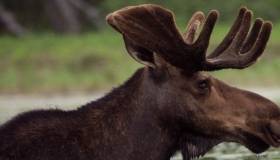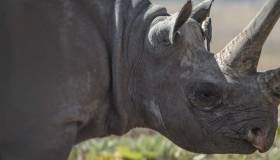
DENVER/February 9, 2021 – Are tick-borne diseases playing a role in moose population declines? Morris Animal Foundation-funded investigators at the University of Maine recently began a study to evaluate the combined effects of winter tick burden and other parasitic infections on moose survival. With this information, the team plans to identify risk factors for survival and develop a model to predict ongoing parasite impact on moose populations.
Many moose populations along the southern edge of their North American range are declining, including those in the northeastern United States. Milder and shorter winters in many states allow ticks to flourish and expand their ranges during months when they would normally be inactive. While metabolic stress due to blood loss from heavy winter tick parasitism has been implicated in moose declines, little is known about the role of tick-borne diseases.
“We know winter ticks are driving some of these declines, but for moose with similar tick loads, the question is why some survive and others do not,” said Dr. Pauline Kamath, Assistant Professor of Animal Health at the University of Maine. “Our goal is to better understand how multiple factors may interact to influence the variability in moose survival.”
Staggering numbers of ticks have been found on some moose, approaching 70,000 ticks per individual. Calves are particularly susceptible to the effects of heavy tick burdens and, said Dr. Kamath, roughly 50% of them may die over a winter. While adults have higher survivability, researchers have found links between ticks and reduced calving rates, which also has a potential effect on moose populations.
Dr. Kamath’s team is working with Maine’s Department of Inland Fisheries and Wildlife, which is gathering blood samples, movement data and tick load counts from about 400 moose in regions known to have a high density of ticks. Researchers will test the blood to measure the current and previous frequency and intensity of blood parasites, such as Anaplasma, a tick-borne, disease-causing parasite.
This information will then help the team develop a statistical model to see what factors drive infection status of an individual and how likely it is a moose can overwinter. Those factors will include an individuals’ age, sex, genetics and level of tick load. Eventually, the team’s findings will be used to predict the trajectory of group population changes over time.
“This study is important not only to help us understand moose population declines, but also examine the effect of climate change on tick-borne disease dynamics,” said Dr. Janet Patterson-Kane, Morris Animal Foundation Chief Scientific Officer. “Ideally, it will help build effective management strategies with wildlife agencies to strengthen and build healthy moose populations across the continent.”
Morris Animal Foundation recently began funding another study that may help decrease moose mortality from winter ticks. Researchers at the University of Vermont are testing the use of commercially available, fungal-based products, which show promise for reducing tick populations and have minimal negative effects on other non-target organisms. The team will apply the products to developing ticks under a variety of conditions to identify the optimal combination that works best to control them.
Morris Animal Foundation, headquartered in Denver, is one of the largest nonprofit animal health research organizations in the world, funding more than $138 million in studies across a broad range of species.
About Morris Animal Foundation
Morris Animal Foundation’s mission is to bridge science and resources to advance the health of animals. Founded by a veterinarian in 1948, we fund and conduct critical health studies for the benefit of all animals. Learn more at morrisanimalfoundation.org.




